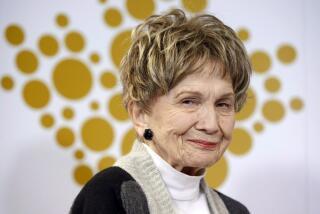Albert Murray dies at 97; novelist, critic bridged words, music
Albert Murray, the influential novelist and critic who celebrated black culture, scorned black separatism and was once praised by Duke Ellington as the “unsquarest man I know,” died Sunday in New York. He was 97.
Murray died at home in his sleep, according to Lewis Jones, a family friend and Murray’s guardian.
Few authors so forcefully bridged the worlds of words and music. Like his old friend and intellectual ally Ralph Ellison, Murray believed that blues and jazz were not primitive sounds, but sophisticated art, finding kinships between Ellington and Louis Armstrong and novelists such as Thomas Mann and Ernest Hemingway.
He argued his case in a series of autobiographical novels, a nonfiction narrative (“South to a Very Old Place”), an acclaimed history of music (“Stomping the Blues”) and several books of criticism. Although slowed by back trouble, Murray continued to write well into his 80s and also helped Wynton Marsalis and others stage the acclaimed Jazz at Lincoln Center concerts. Millions of television viewers came to know him as a featured commentator in Ken Burns’ documentary series “Jazz.”
An amiable counterpart to the aloof Ellison, Murray was many men: friend of Ellington and artist Romare Bearden (whose paintings hung in Murray’s Harlem apartment); foe of Marxists, Freudians, academics, black nationalists and white segregationists; and mentor and inspiration to Ernest J. Gaines, Stanley Crouch, James Alan McPherson and many others.
Marsalis, in the book “Moving to Higher Ground,” remembered visiting Murray in Harlem amid decades worth of “books and recordings of the most meaningful ideas in the history of humanity.”
“He was asking you to pull down this book and that one and go to chapter so-and-so and page so-and-so, and on that page what he was talking about, and it was everything from Plato to John Ford to Frederick Douglass to thermonuclear dynamics to James Brown,” said Marsalis, who cited “Stomping the Blues” as a profound influence on his music and his life.
Murray often wrote and spoke in a jazzy, mock-professorial style, not unlike Ellington’s stylized stage introductions. One Murray book was titled “The Blue Devils of Nada: A Contemporary American Approach to Aesthetic Statement.” He declared that blacks should not be regarded as transplanted Africans, but quintessential Americans, practiced in the art of “I-ma-gi-na-tive ex-al-ta-tion.”
Interviewed by the Associated Press in 1998, the raspy-voiced Murray defined the blues as “the extension, improvisation and ritualization of the stylization of the beliefs and the feelings and emotions of the lifestyle of a particular culture.”
“People want to say the blues is an ailment,” Murray said, waving his hand. “Any fool can tell you the blues is good-time music. It’s entertainment. It ain’t for no church. ‘Kill the white folks,’ that’s not what the blues is about. You see the blues with that stuff, it means some Marxist got hold of that.”
Born May 12, 1916, Murray grew up in Magazine Point, Ala., not far from Mobile. Like his fictional alter ego, Scooter, he was a boy who simultaneously knew and did not know who he was. At age 11, he learned, accidentally, that the couple raising him were not his parents; his mother had given him up for adoption out of shame for conceiving him out of wedlock. His real parents were educated and middle-class, his adopted ones common folk.
Murray, bright, self-confident and a born improviser, came to see himself as the adventurer-hero of his own life, a “prince among paupers.” He left his hometown to study at the Tuskegee Institute in Alabama, where Ellison was an upperclassman. Murray graduated in 1939, served in the Army Air Forces during World War II and received a master’s degree from New York University.
Though Ellison attained instant fame in the early 1950s with his first novel, “Invisible Man,” Murray’s turn came more than a decade later. Before publication came the prelude: books read, records remembered, paintings appraised, experiences experienced, what Murray called “the also and the also” of constructing an identity that would reconstruct the identity of American culture.
“I was figuring out what kind of a writer I was going to be,” he said. “I didn’t have it together.”
He finally broke through in the late 1960s, at the peak of the Black Arts Movement, which regarded art as an outlet for protest. Murray ridiculed this and other political art as “social science fiction.” Like Ellison, he believed conflict was a given, that life was not a formula to be solved but a dance to be danced.
“(E)ven the most exuberant stomp rendition is likely to contain some trace of sadness as a sobering reminder that life is at bottom, for all the very best of good times, a never-ending struggle,” Murray once wrote.
Murray’s belated success had one apparent casualty: his bond with Ellison. The two drifted apart in later years, with friends speculating that Ellison, who never completed another novel after “Invisible Man,” resented Murray’s good fortune, while Murray tired of being labeled Ellison’s protege.
In 2000, the Modern Library released “Trading Twelves,” a collection of letters between Murray and Ellison, who died in 1994.
Murray was married to Mozelle Menefee Murray, whom he met in Tuskegee in 1941. They had a daughter, Michele, who performed with the Alvin Ailey dance troupe.
Italie writes for the Associated Press.
More to Read
Start your day right
Sign up for Essential California for the L.A. Times biggest news, features and recommendations in your inbox six days a week.
You may occasionally receive promotional content from the Los Angeles Times.






